Source: m.phnompenhpost.com
The design for Cambodia’s first Baha’i temple has now been unveiled. For the country’s 12,000 believers, it’s a proud moment of recognition for their message of peace
It’s 530am and a trail of just-awake men and women are making their way across a soggy field about 7 kilometres outside Battambang. At a spot some 50 metres into the field, they stop.
There is chatting and stretching as late arrivals make their way across the grass.
A single voice starts singing, and the group joins in. As the day dawns, the singing continues and the peaking sun casts long shadows along the ground.
The singing is soft but assured, sometimes in Khmer, sometimes in English, but always with the same evocative cadence and trembling half notes of local melodies. The lyrics speak of unity, of worship and of peace.
“Blessed is the spot, and the house, and the place . . . and the meadow where mention of God hath been made, and His praise glorified.”
For Battambang’s Baha’i community, who follow the peaceful teachings of the 19th-century Persian prophet Baha’u’llah, this meadow has been blessed above all others.
The project is not expected to take longer than a year to complete, as no building in the complex will be higher than one storey.
Since plans for the temple design were unveiled last month, every morning has begun with prayers in this same spot.
“God is everywhere,” explains a young believer as he walks back to the road, the sun now well above the horizon. “But now God is here in particular.”
A global religion
There are currently about 12,000 Baha’is living in Cambodia, about half in Battambang province and the rest in small communities dotted across the country.
After Christianity, it is the world’s most geographically diverse religion, and the only religion to have grown proportionately faster than the population of the world in all major areas over the past century. It is hard to arrive at estimates for the total size of the global congregation, but it is at least 5 million strong.
The new temple marks Cambodia out as special.
The site was ordained by the Universal House of Justice – the supreme body of the Baha’i faith based in Haifa, Israel – the reason that Battambang’s Baha’i community face northwest as they pray.
It is one of only five local worship houses to have been approved (and majority funded) by the supreme governing body in Israel.
The other four are planned for towns where, like Battambang, there is already a strong regional congregation of Baha’is outside the national capital.
These sites are in India, Kenya, Colombia and the tiny South Pacific ocean nation of Vanuatu.
“It’s a question that’s asked by a lot by Baha’is in other countries: Why was Battambang chosen?” says Hou Sopheap, an earnest member of the temple construction committee.
“I think the Baha’i community of Battambang is ready to follow whatever Baha’u’llah’s teachings are. So it’s [because of] our readiness to obey the institution.”
A growing faith
Mention of Baha’i communities in Cambodia can be found as far back as the 1920s, but it was during the post-1992 UNTAC period that the community expanded most rapidly, through the proselytising of mainly Asian expats and aid workers.
“I was working for one Baha’i family as a nanny,” recalls Keo Yvette – a 66-year-old who discovered the faith during the UNTAC period.
“One of their friends gave me a reading book about being Baha’i and I thought, ‘wow, this is really nice’. I went to all the holidays and feasts with the family, and after that, I became a Baha’i.
My son started to pray with the children that I was taking care of.”
Like most missionaries (the Baha’i prefer the term “pioneers”), the Baha’i often proselytise through education setting up centres for the faithful, who are then tasked with attracting newcomers through their programs.
“I’ll come for three months and go to villages all over – in Pursat, Kampong Thom, Preah Vihear .
“Usually I come here when there’s a need – when there’s a village with a growth of the Baha’i community and they need a place to have some learning and some prayers.”
But the pioneers are keen to emphasise that the focus of the classes, at least at the entry level, is far less on the particulars of the Baha’i faith than it is on prompting general reflection on morality and spirituality.
“It’s not like the Christian missionaries,” says Yvette in Phnom Penh. “People don’t worry we are taking their children away from Buddhism.”
Through their youth programs, the Baha’i are fervent do-gooders, dedicating themselves to everything from litter picking to teaching foreign languages. As a result, they generally have good relations with local government as well as local villagers.
A place to call home
The plans unveiled last month for the Local House of Worship suggest it will be a striking, spacious campus. As well as a temple which the Baha’i emphasise will be open to members of all religions there will be a study centre, administrative block and dormitories for long-distance visitors facilities the Baha’i hope will solidify Battambang’s reputation as a regional hub for the faithful.
The cost of the project is not yet fixed.
Those involved said they believe it would be more than $1 million, but they are not yet sure how much more. Funding will come from Baha’is all over the world, who are obliged to “give back” to the faith as part of their devotion.
The man behind the complex’s design is Tang Sochet Vitou, an architect based in Phnom Penh.
Vitou is enthused by the project, partly because his mandate left so much room for creative expression “All wats in Cambodia look the same,” he laments but also because of the Baha’i faith – in which he received a crash course prior to bidding for the project.
Vitou is Buddhist, but discovered a strong affinity with Baha’i practices, agreeing with devotees who say that the faith promotes the same principles as Buddhism, but makes them more actionable.
“They are more giving, more sharing, more promoting unity.”
The unveiling of Vitou’s design has enthused the Baha’i community around the country.
Even though half the national population will not be able to pray there in person with any regularity, they believe the temple signals that Cambodia is evolving spiritually in a way that will one day bring about world peace.
“This is a gift to us a bounty of blessing,” says Yvette, sitting in the small shophouse in Tuol Kork that is used as the prayer room in Phnom Penh.
Her son Davuth nods. “It has given us more spirit to strive.”
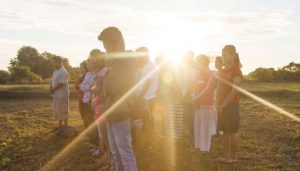
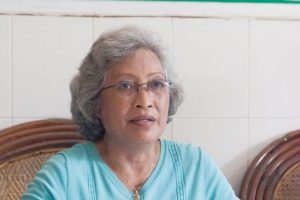
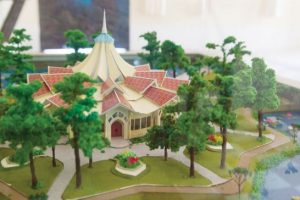

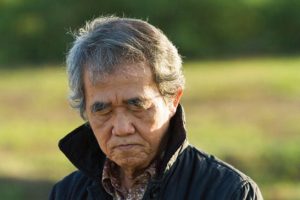
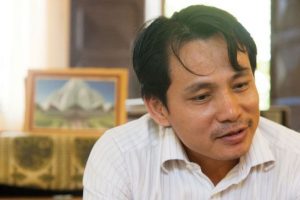
August 19, 2015 5:44 pm
God bless the Cambodian Baha’i community , and especially Battambang. I hope to visit the temple at its dedication ceremony. You make us proud.